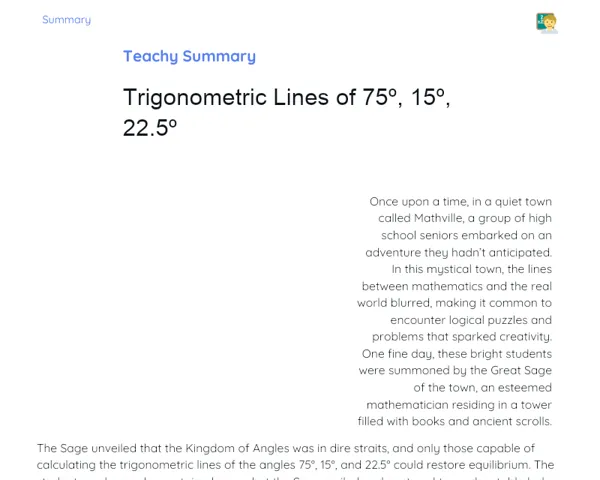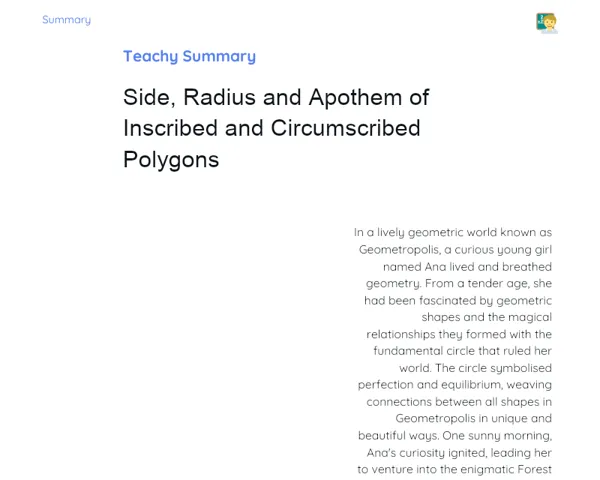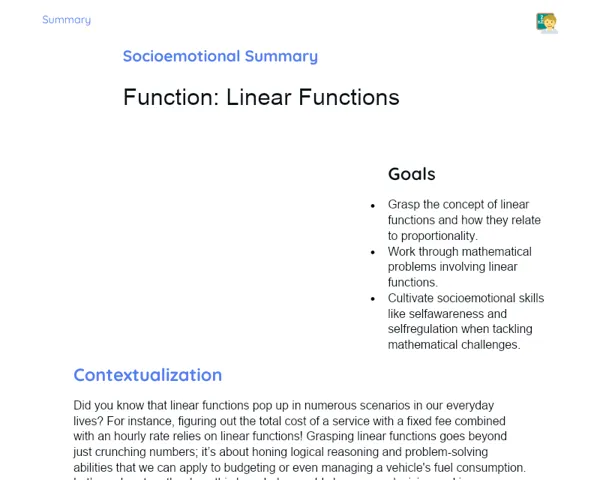Socioemotional Summary Conclusion
Goals
1. Grasp the concept of Arithmetic Progression (AP).
2. Learn how to calculate the sum of an Arithmetic Progression.
3. Be equipped to tackle real-world problems involving sums of AP.
4. Cultivate socio-emotional skills like self-regulation and collaboration.
Contextualization
Did you know that the sum of an Arithmetic Progression can be useful in many everyday scenarios, such as budgeting for a project or organising events? Learning about AP not only sharpens your logical thinking but also highlights the significance of patience and perseverance. Let’s dive in and see how it all works! 🚀
Exercising Your Knowledge
Definition of Arithmetic Progression (AP)
An Arithmetic Progression (AP) is a sequence of numbers where each term after the first is obtained by adding a fixed number (the common difference) to the previous one. This setup is valuable for recognising patterns and addressing practical issues involving regular totals.
-
Example: In the sequence 2, 5, 8, 11..., the common difference is 3.
-
Importance: Grasping the idea of constant addition fosters logical thinking.
-
Socio-emotional Connection: This concept teaches us the value of consistency and patience. Every step in learning is like a small addition that contributes to our growth.
Formula for the nth term (an)
The formula for the nth term enables us to find any term in the AP without needing to list all the previous terms. The formula is: an = a1 + (n-1) * d, where a1 is the first term, d is the common difference, and 'n' is the term number.
-
Example: To find the 5th term of the AP 2, 5, 8, 11..., we use the formula: a5 = 2 + (5-1) * 3 = 14.
-
Importance: It simplifies solving complex problems, negating the need for burdensome computation.
-
Socio-emotional Connection: Utilising this formula teaches us foresight and strategic planning. Recognising that consistent effort (common difference) leads us to a goal (nth term) resonates deeply in life.
Formula for the Sum of the first n terms (Sn)
The sum of the first n terms of an AP is given by the formula Sn = n/2 * (a1 + an). This formula is crucial for quickly calculating the total of a large series of terms.
-
Example: To find the sum of the first 5 terms of the AP 2, 5, 8, 11, 14, we use the formula: S5 = 5/2 * (2 + 14) = 40.
-
Importance: Enables speedy summation of lengthy sequences, aiding in resolving real-world issues.
-
Socio-emotional Connection: Just like the sum of an AP, our accomplishments are the result of many small consistent steps. Learning this formula helps us appreciate each minor achievement as we work towards a larger goal.
Key Terms
-
Arithmetic Progression (AP): A sequence of numbers where each term has a constant added, known as the common difference.
-
Common difference: The fixed number added to each term to find the next in the series.
-
nth term (an): The term in the 'n' position in an AP, calculated using the formula an = a1 + (n-1) * d.
-
Sum of the first n terms (Sn): The total of the first n terms of an AP, calculated by Sn = n/2 * (a1 + an).
For Reflection
-
How can understanding Arithmetic Progressions assist with personal and academic goal setting?
-
In what ways can the patience and persistence fostered through AP be applied in other life areas?
-
What strategies have you employed to manage your emotions while working in groups? How did this shape the outcome?
Important Conclusions
-
The Arithmetic Progression (AP) is a valuable mathematical approach that aids us in understanding and computing regular totals in a sequence.
-
Grasping the formula for the sum of the first n terms of an AP (Sn = n/2 * (a1 + an)) is vital for solving practical problems swiftly and effectively.
-
Studying AP teaches crucial socio-emotional skills like patience, persistence, and predictability that can be beneficial in various dimensions of life.
-
Collaborating in groups and applying AP formulas fosters the development of essential social and emotional skills, such as self-regulation and collaboration.
Impacts on Society
The use of Arithmetic Progressions is widespread and can be seen in numerous daily activities. For instance, when budgeting for a long-term project, calculating installments, or even coordinating events such as sports leagues and tournaments. Understanding the sum of AP allows for precise predictions and better resource management.
Additionally, the patience and perseverance nurtured through studying AP are fundamental emotional skills. Realising that each small step contributes to the overall goal helps us value gradual progress, even when outcomes take time to materialise. This attitude is crucial for overcoming challenges and accomplishing significant life goals.
Dealing with Emotions
To manage your emotions while tackling AP, consider implementing the RULER method in your daily routine. First, identify the feelings that come up during your studies (frustration, satisfaction, anxiety). Understand what triggers these emotions – it could be a specific challenge or a success in solving a problem. Properly naming these emotions helps clarify what you're experiencing. Express these sentiments appropriately, be it through conversation with a friend or journaling. Lastly, regulate your emotions by adopting healthy strategies, such as the guided mindfulness exercises we practice in class.
Study Tips
-
Create practical examples to enhance your understanding of the formula for the sum of an AP. Think of everyday scenarios, like adding up your weekly savings.
-
Engage in problem-solving with your peers. Besides grasping the content, you’ll build communication and teamwork skills.
-
Set achievable study goals, like solving a specific number of problems each day. This will facilitate focus and keep your motivation high!



